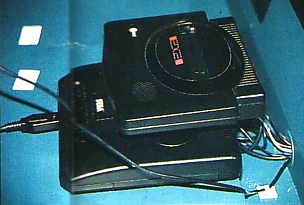Difference between revisions of "Edge 16"
From Sega Retro
| Line 11: | Line 11: | ||
The Edge 16 was a device to be inserted into the cartridge slot of a Mega Drive console, allowing two players to compete with Mega Drive games through the internet - control pad signals would be sent through the phone line, as would sounds from a microphone to allow players to communicate. A card slot at the front of the device would have been used to save game data to memory cards. {{fileref|CVG UK 141.pdf|page=20}} | The Edge 16 was a device to be inserted into the cartridge slot of a Mega Drive console, allowing two players to compete with Mega Drive games through the internet - control pad signals would be sent through the phone line, as would sounds from a microphone to allow players to communicate. A card slot at the front of the device would have been used to save game data to memory cards. {{fileref|CVG UK 141.pdf|page=20}} | ||
| − | Announced in July 1993 at the [[Summer CES 1993]], AT&T pulled out of the Edge 16 project before the peripheral could be released, however it is known to have appeared at [[Winter CES 1994]], in which players could fight each other with specifically adapted versions of ''[[Ballz 3D]]''. Supposedly the system was finished and ready to go by September 1994, but AT&T changed their mind about entering the games industry and the product was left to collapse. | + | Announced in July 1993 at the [[Summer CES 1993]], AT&T pulled out of the Edge 16 project before the peripheral could be released, however it is known to have appeared at [[Winter CES 1994]], in which players could fight each other with specifically adapted versions of ''[[Ballz 3D]]''. Supposedly the system was finished and ready to go by September 1994, but AT&T changed their mind about entering the games industry and the product was left to collapse. It would have been priced somewhere between $100 and $150 USD{{ref|https://archive.org/stream/EDGE.N001.1993.10-Escapade/EDGE.N001.1993.10-Escapade_3300px#page/n13/mode/2up}}. |
The concept of the Edge 16 would be revived with the [[XBAND]] some months later. It is unlikely the Edge 16 was ever set to be sold outside of North America. | The concept of the Edge 16 would be revived with the [[XBAND]] some months later. It is unlikely the Edge 16 was ever set to be sold outside of North America. | ||
Revision as of 10:55, 23 January 2016

|
| Edge 16 |
|---|
| Made for: Sega Mega Drive |
| Manufacturer: PF Magic, AT&T |
The Edge 16 is an unreleased modem built specifically for the Sega Mega Drive under license by Sega by PF Magic and AT&T.
The Edge 16 was a device to be inserted into the cartridge slot of a Mega Drive console, allowing two players to compete with Mega Drive games through the internet - control pad signals would be sent through the phone line, as would sounds from a microphone to allow players to communicate. A card slot at the front of the device would have been used to save game data to memory cards. [1]
Announced in July 1993 at the Summer CES 1993, AT&T pulled out of the Edge 16 project before the peripheral could be released, however it is known to have appeared at Winter CES 1994, in which players could fight each other with specifically adapted versions of Ballz 3D. Supposedly the system was finished and ready to go by September 1994, but AT&T changed their mind about entering the games industry and the product was left to collapse. It would have been priced somewhere between $100 and $150 USD[2].
The concept of the Edge 16 would be revived with the XBAND some months later. It is unlikely the Edge 16 was ever set to be sold outside of North America.
Promotional Material
Magazine articles
Mean Machines Sega #10 (1993-08)
